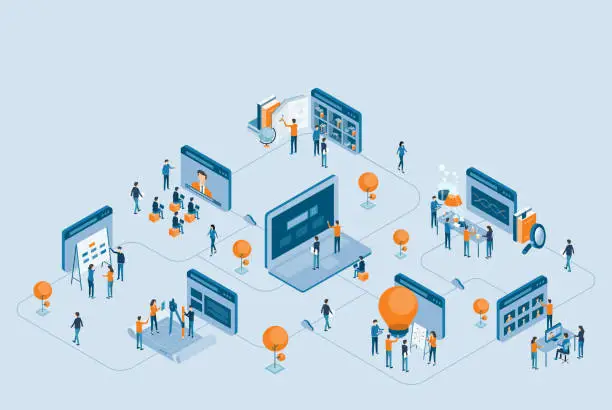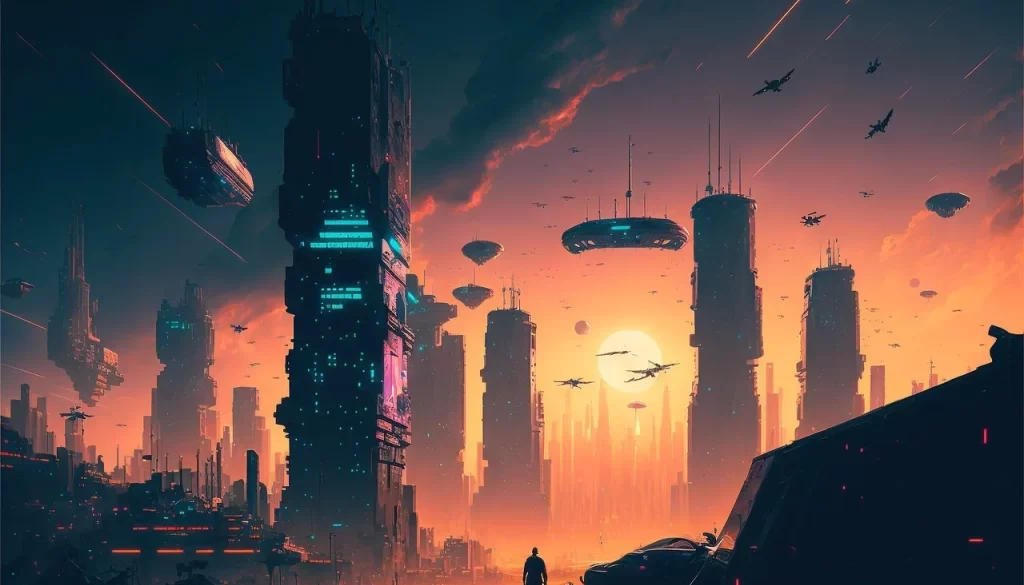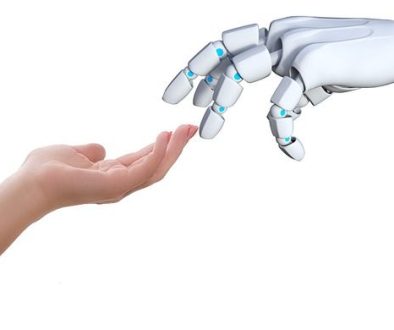Beyond Boundaries – A Glimpse into a Technological Odyssey
In the era since the beginning of the 21st century, technology has progressed rapidly. Our reality now encompasses things that were once mere dreams in recent decades. Considering the unfolding of the past, I felt intrigued about what the next 30 years might hold. Consequently, I delved into exploring what life could resemble for us in 2050. Let’s delve into this glimpse.

Nanotechnology: The Brain-Computer Interface
- Unleashing the Power of Nanotechnology
- Merging Minds and Computers: The Nanobot Revolution
Over the years, scientists have achieved remarkable breakthroughs and unearthed numerous innovative applications for nanotechnology. As it stands, nanotechnology holds the potential to revolutionize life as we currently understand it. Specialists in this domain believe that nanobots will, in future, be implanted into our brains, facilitating a swifter and more immediate connection to the virtual world through brain-computer interface technology. The melding of the mind and computer will empower humans, granting them access to boundless information and solutions to challenges the mind alone might struggle to solve. If nanotechnology advances to this stage, there might be no need for devices like phones and calculators. This is particularly exciting for the future student. It appears that math may no longer pose a universal challenge.
3D Print Technology: Printing the Future
- The Evolution of 3D Printing
- Envisioning the Future of 3D Printing
Anticipated on the tech horizon is the burgeoning of 3D print technology. Though already advanced, we can foresee further enhancements by 2050. Presently, we can 3D print tools and homes. In the future, we may be able to print additional tools and perhaps even modes of transportation if larger machines are constructed. Accessibility to this technology will broaden, allowing anyone interested in a 3D printer to explore infinite possibilities. If the ongoing trend of open-source 3D printable files continues, it won’t be long before everyone is printing substantial objects such as furniture and tools. Here’s a thought: what about creating an affordable 3D printer for food? That could potentially mark the end of world hunger.
Medical Advancements: A Glimpse into Immortality
- From Phones to Immortality: The Medical Horizon
- The Potential Eradication of Death
Amidst global warming, medical advancements are expected. Transition from the obsolescence of phones to the potential eradication of death. By 2050, the finality of death might become a relic of the past. With the brain interfaced with a computer through BCI technology, the information stored in our brains can be transferred into computer files akin to hard disks. This implies that data, including memories, could be retrieved and uploaded into another entity, perhaps a more advanced humanoid robot. In this manner, the brightest minds across various fields can be preserved, continuing their work on innovations. Another medical advance to ponder is the potential cure for serious illnesses like cancer. The caveat, of course, is that each new technology tends to be prohibitively expensive initially, meaning the majority of us might not access this life-saving technology for some time.
Transportation: A Shift in Movement
- Autonomous Vehicles: A Future of Safer Transportation
- The Hyperloop Vision: Speeding into the Future

A facet we might gain access to is transportation in 2050. Transportation will have undergone profound changes. With ongoing experimentation on self-driving cars by manufacturers like Tesla, it’s not far-fetched to imagine that by 2050, the technology for fully automated vehicles will be a reality. Noteworthy benefits of such autonomous vehicles include a significant reduction in traffic-related fatalities as these vehicles will sync with traffic control systems. Another advantage is the lifestyle transformation self-driving vehicles will bring. Without the need to operate a vehicle, people can opt to relax or be more productive during their travels. This translates to a substantial amount of free time, considering the time spent in traffic. An intriguing development is the Hyperloop One project by Elon Musk, aiming to shift most of public transportation underground using electromagnetic levitation at remarkable speeds of 310 kilometers per hour. This concept offers the potential for a faster, cost-effective, and eco-friendly mode of transportation. If a larger segment of the population embraces it, there could be even fewer traffic-related incidents.
Fuel: Embracing Renewable Energies
- Transitioning to Renewable Energy
- Blue Rise and Ocean Thermal Energy: A Sustainable Future
Staying within the realm of transportation, all future transportation modes will rely on renewable energy sources. Currently, the world grapples with global warming and the looming depletion of natural resources. Hence, it is imperative that we transition to a more sustainable energy source. Presently, Hyperloop One explores electromagnetic levitation, and the automobile industry is actively seeking ways to reduce harmful vehicle emissions. These efforts are all aimed at the overarching objective of phasing out the use of carbon-emitting fuels. In addition to these, research is being conducted on harnessing wind, solar, and thermal energy from the ocean. A specific company, Blue Rise, a specialized ocean thermal energy conversion developer, is working on a project that could potentially eliminate the need for fossil fuels. Hopefully, Blue Rise and their counterparts will achieve success soon, thereby mitigating some of the environmental challenges we face.
Space Exploration: Our Ticket to Survival
- Journey to the Stars: The Potential of Space Exploration
- Space Tourism: A Glimpse into the Extraordinary
If there’s one aspect mentioned as a possible solution for our current environmental challenges, it’s space exploration and colonization. Companies like SpaceX and Blue Origin are dedicated to transforming space technology, aiming for spatial exploration and ultimately enabling human habitation on other planets in colonies. With significant strides already made, it’s anticipated that by 2050, space tourism will become a reality for those with the means. The array of holiday destinations may expand to encompass places like Mars and the moon. Unfortunately, orbit trips will be notably costly, making them exclusive, at least initially, to the very affluent.
Artificial Intelligence: The Rise of Machines
- The Unfolding AI Revolution
- The Impending AI Impact on Society and Jobs
Something potentially accessible to everyone is artificial intelligence. Already more advanced than most innovations discussed here, the evolution of artificial intelligence will continue to progress over the years. Experts in this domain anticipate that AI will surpass the processing capabilities of living brains. This wouldn’t be concerning if it didn’t open the door to a potential robo-apocalypse. Fortunately, scientists still need to figure out how to instill essential human values into AI before it can seamlessly integrate into our daily lives. However, the rise of AI will undeniably reshape the workforce, leading to radical shifts in the job market. Given the current trajectory, about half of the world’s existing jobs could be replaced by AI machines and robots. By 2050, the world will be even more interconnected and data-driven than it is today. Many of us will likely need to consider a change in career paths.
Education: The Digital Classroom
- The Digital Transformation of Education
- AI-Powered Learning: A New Paradigm

As the job market transforms, education will also experience significant changes. Already, we’ve witnessed a surge in digital learning, especially during the pandemic. By 2050, fully digital schools will be commonplace. Even if we physically attend schools, they may no longer necessitate traditional books, opting for tablets and laptops instead. In higher education, experts predict that over 70 percent of the student population will enroll in online degree programs, making education more globally accessible. This shift is a positive step towards making quality education within reach for all. I envision online degrees being taught by AI-powered robots at that time. These robots might be capable of creating course material, delivering lectures, and assessing assignments. Sadly, you might not be able to negotiate a deadline extension with a robot lecturer.
The Metaverse: Beyond Reality
- Understanding the Metaverse
- The Metaverse in 2050: A Virtual Reality Odyssey
Now, let’s shift our focus to the metaverse. Ever since Facebook CEO Mark Zuckerberg’s announcement, virtual reality and AI have become integrated into our daily lives through the social media giant. For those who might be a bit perplexed about the metaverse, you’re not alone, and you’ve come to the right place. The metaverse is a computer-generated, virtual reality environment where users can interact with each other through AI-enabled software. Essentially, it’s about simulation, with avatars representing users. As metaverse functionalities advance, by 2050, it could provide a complete virtual experience, encompassing activities from shopping to travel, all from the comfort of your home. People will have the opportunity to share their virtual experiences with the world. Imagine going on a trip to your favorite holiday destination with your family, all while physically being elsewhere. That’s what the metaverse will offer. It seems the more we connect, the more we’re driven apart.
Money: The Digital Currency Era
- The Decline of Physical Cash
- Evolving Financial Transactions: A Digital Future
Despite the continued use of money, one aspect that’s gradually declined over the years is physical cash. Following this trend, cash will most likely be obsolete by 2050. All transactions will be conducted virtually, and new modes of financial transactions will emerge due to AI and decentralized finance. As the world gradually adopts these technologies, we might not even have to do our own grocery shopping anymore, rendering traditional paper and plastic currency even less necessary. Similar to Tesla, which orders its own car parts as needed, our automated pantries and refrigerators might take care of our grocery needs. No more getting the wrong type of milk or running out of it.
Real Estate: Homes of the Future
- The Automation of Home Appliances
- The Hologram TV Experience
Talking about the automation of home appliances, homes in 2050 will be fully automated—smart homes. While smart homes already exist, the advancements in the coming decades will significantly surpass what we have today. Smart homes in 2050 will boast complete AI activation functions, allowing homes to sense our moods and requirements without a single command. Additionally, interactive hologram televisions will be a reality, enabling you to verbally summon your hologram TV, which will appear right in front of you. The best part? You’ll never have to search for the remote again because you can control the TV with your mind using nanotechnology, as discussed earlier. Thus, we’ve come full circle in this exploration of what our lives may look like in 2050. To be honest, this is purely an exercise of imagination, and I acknowledge that not everything discussed here will come true. However, it’s hard to deny that none of this is too far-fetched, considering humanity has already laid the groundwork for many of these technologies. Regardless, one thing is certain with the trajectory of technology, I have no doubt that the world will be vastly different by 2050. I hope our current societal systems and structures will effectively adapt to these forthcoming innovations.
So, I hope this article has been informative for you, and I’d like to thank you for viewing.



